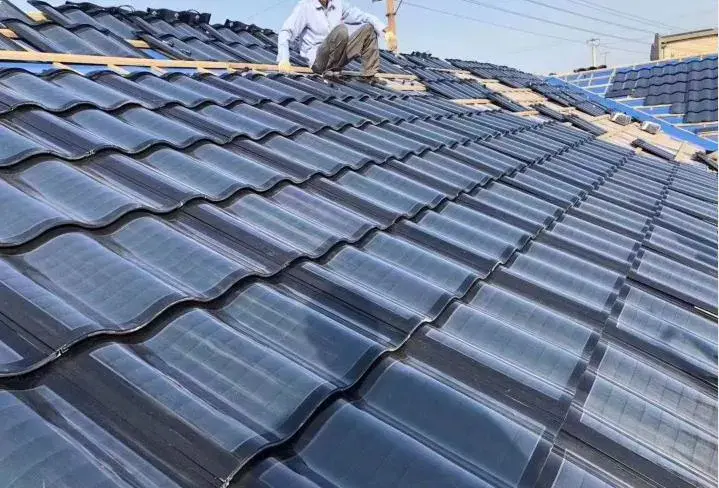
As renewable energy continues to gain traction, homeowners face a pivotal choice between solar roof tiles and traditional solar panels. By 2025, advancements in technology and design will shape their effectiveness, aesthetics, and costs. This comparison explores the pros and cons of each option, helping you make an informed decision on the best solar solution for your needs.
As we approach 2025, the solar energy market continues to evolve, with innovations shaping how we harness the power of the sun. Two significant options available to homeowners are **solar roof tiles** and **traditional solar panels**. While both serve the same purpose — converting sunlight into electricity — they differ in design, installation, and overall efficiency. Understanding these differences can help homeowners make informed decisions about their solar energy investments.
**Solar roof tiles**, also known as building-integrated photovoltaics (BIPV), are designed to replace conventional roofing materials. They blend seamlessly into the structure of your roof, providing a dual function of energy generation and protection from the elements. These tiles are typically made from materials like tempered glass and offer a sleek, aesthetically pleasing appearance.
**Traditional solar panels**, on the other hand, are standalone units that are mounted on the roof or on the ground. They consist of silicon photovoltaic cells encased in a protective layer, usually made from glass or plastic. Traditional panels have been the standard for solar energy systems for decades and are known for their efficiency and reliability.
One of the most critical factors in choosing between **solar roof tiles** and **traditional solar panels** is cost. As of now, solar roof tiles tend to be more expensive upfront due to their technology and manufacturing processes. However, as advancements continue and production scales increase, prices are expected to decrease by 2025.
Here’s a simplified comparison of the costs:
| Type | Average Cost per Watt | Installation Cost |
|---|---|---|
| Solar Roof Tiles | $3.00 - $4.50 | Higher due to specialized installation |
| Traditional Solar Panels | $2.50 - $3.50 | Standard installation costs |
When comparing efficiency, traditional solar panels generally have higher conversion rates, converting more sunlight into electricity. Most traditional panels boast efficiencies ranging from 15% to 22%, while solar roof tiles typically range from 12% to 18% efficiency.
However, advancements in **solar technology** are rapidly improving the performance of solar roof tiles. By 2025, we may see solar roof tiles that can compete more closely with traditional panels in terms of efficiency, especially as the industry focuses on innovation.
One of the main advantages of **solar roof tiles** is their aesthetic appeal. Homeowners who prioritize a seamless look may prefer solar tiles since they integrate directly into the roofing structure, maintaining the home's architectural integrity. This can potentially enhance the property’s value.
In contrast, traditional solar panels can sometimes be viewed as bulky or visually unappealing, potentially detracting from a home's curb appeal. However, this can vary based on individual preferences and neighborhood standards.
The installation of solar roof tiles is generally more complex and time-consuming than traditional solar panels. Solar roof tiles require a skilled installer familiar with both roofing and solar technology, which can lead to higher labor costs. In contrast, the installation of traditional solar panels is more straightforward and can often be completed in less time, resulting in lower labor costs.
Both **solar roof tiles** and **traditional solar panels** are designed to withstand various weather conditions. However, traditional panels are typically more robust and have been tested against hail, wind, and snow loads for longer periods. Solar roof tiles, while durable, may require more careful maintenance to ensure their longevity, particularly if they are integrated into a roofing system that is already aging.
Both options offer significant environmental benefits by reducing reliance on fossil fuels and lowering greenhouse gas emissions. However, the manufacturing processes differ. Traditional solar panels have a more established recycling process, while solar roof tiles are still developing in this area. By 2025, we can expect improvements in sustainability practices for both technologies.
As we look forward to 2025, the solar energy landscape is set to change dramatically. With advancements in **solar technology**, changes in cost structures, and increased awareness of environmental issues, homeowners will have more options than ever. Traditional solar panels are likely to remain popular due to their efficiency and cost-effectiveness. However, solar roof tiles may gain traction as they become more affordable and efficient, appealing to those looking for aesthetic value.
Ultimately, the choice between **solar roof tiles** and **traditional solar panels** will depend on individual preferences, budget, and long-term goals for energy efficiency. As technology continues to evolve, homeowners can expect to see even more innovative solutions in the solar energy market.

Cost and Financial Benefits of Solar Roof Tiles in 2025
The Future of Solar Roof Tiles in the USA: Trends and Innovations for 2025
Top Benefits of Installing Solar Roof Tiles in Your Home by 2025
How Solar Roof Tiles Can Increase Your Home's Value in 2025
The Best Solar Roof Tile Brands to Watch in the USA for 2025
Government Incentives and Rebates for Solar Roof Tiles in the USA by 2025
A Comprehensive Guide to Choosing the Right Solar Roof Tiles for Your Home in 2025

The Environmental Impact of Solar Roof Tiles: What We Can Expect in 2025